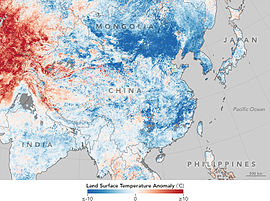 January 2016 East Asia cold wave
January 2016 East Asia cold waveIn late January 2016, a cold wave struck much of East Asia, parts of mainland Southeast Asia and parts of northern South Asia, bringing record cold temperatures and snowfall to many regions. Sleet was reported in Okinawa for the first time on record, and many other regions saw their coldest temperatures in decades. Snowfall and frigid weather stranded thousands of people across four countries. At least 85 people in Taiwan died from hypothermia and cardiac arrest following a sudden drop in temperature during the weekend of January 22–24. The cold claimed a further fourteen lives in Thailand, and snowstorms resulted in six deaths across Japan. This event was driven by a fast Arctic warming that occurred within the troposphere, forcing the Arctic Oscillation to change phase rapidly from positive (in late December) to negative (in late January), facilitating the atmospheric blocking and associated Siberian high buildup.
On 24 January, the temperature at the Hong Kong Observatory fell to 3.1 °C (37.6 °F), the coldest in 59 years. Hundreds of people hiked up Tai Mo Shan for sightseeing, where temperatures fell to a record low of −6.0 °C (21.2 °F). Many were also on Tai Mo Shan participating in a 100 km marathon. 129 required rescue and 67 were hospitalised for signs of hypothermia. The Fire Services Department (FSD) deployed 53 fire appliances, 39 ambulances and more than 300 personnel. The Government Flying Service evacuated eight patients by helicopter from Tai Mo Shan and Sunset Peak to Pamela Youde Nethersole Eastern Hospital and the airport. The FSD also responded to 130 calls at Kowloon Peak. In addition, the Civil Aid Service and Hong Kong Police Force were mobilised.
...
Wikipedia